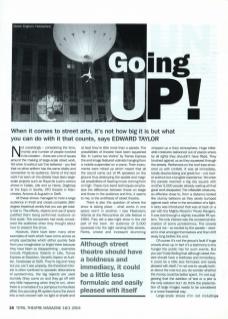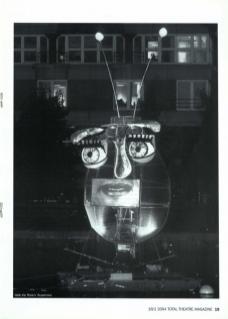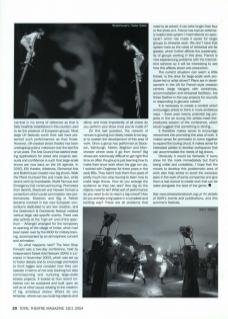Not surprisingly – considering the time, money and number of people involved in its creation – there are a lot of issues around the making of large-scale street work. Yet when it works it can't be bettered – you feel that no other artform has the same vitality and connection to its audience. Some of the best work I've seen on the streets have been large-scale projects such as Royal de Luxe's various shows in Calais, Lille and Le Havre, Dogtroep at the Expo in Seville, KTO theatre in Manchester, Amoros & Augustin in Delft.
All these shows managed to hold a large audience in thrall and create complete 360-degree theatrical worlds that you can get totally lost in. The effects, objects and use of space justified them being performed outdoors on that scale. The companies had really considered the audience when they thought about how to present the show.
However, there have been many other examples of work which have come across as empty spectacles which either quickly fade from your imagination or linger there because they have been so disappointing – examples include Plasticiens Volants in Lille, Transe Express at Stockton, Generik Vapeur at Aurillac, Carabosse at Delft. They're big and noisy but you can't see properly, the theatrical interest is often confined to sporadic detonations of pyrotechnics, the big objects are used clumsily (they come on and they go off with very little happening when they're on), when there is a narrative it's a pompous humourless affair, the pounding PA system turns the event into a rock concert with no light or shade and at best they're little more than a parade. The possibilities of theatre have been squashed flat. In Lacher les Violins by Transe Express the end image featured violinists hanging from a mobile suspended on a crane. Their instruments were miked up which meant that all the sound came out of PA speakers on the ground thus destroying the spatial and magical possibilities of hearing music coming from on high. These rock-band techniques emphasise the difference between those on stage and those in the audience and this, it seems to me, is the antithesis of street theatre.
There is also the question of where the show is taking place – what works in one space won't in another. I saw Plasticiens Volants at the Rencontres de Lille festival in 1994. They did a late-night show in the old part of the town. An audience of 5000 squeezed into the tight winding little streets. Flares, smoke and incessant drumming whipped up a thick atmosphere. Huge inflatable creatures ballooned out of places where by all rights they shouldn't have fitted. They brushed against us as they squeezed through the streets. Performers on the rooftops showered us with confetti. It was all immediate, totally disorientating and great fun – not rocket science but a tangible experience. Yet when the parade reached a big city square with another 5000 people already waiting all that good work dissipated. The inflatable creatures, so effective close-to, from a distance looked like clumsy balloons as they slowly bumped against each other in the simulation of a fight. A story was introduced that was at best on a par with the Mighty Morphin' Power Rangers. It was told through a slightly inaudible PA system. The only interest was the occasional detonation of some pyrotechnics. The crowds around me – so excited by the parade – started to chat amongst themselves and then drift away long before the end.
Although street theatre should have a boldness and immediacy, it could be a little less formulaic and easily pleased with itself
Of course it's not the group's fault if huge crowds show up. In fact it's a testimony to the hunger the public has for such events. But you can't help feeling that although street theatre should have a boldness and immediacy, it could be a little less formulaic and easily pleased with itself. I'm not one to usually bother about the cost but you do wonder whether the money could be better spent. I'm not suggesting that the addition of text or a plot is the only solution but I do think the presentation of large images needs to be considered in a more theatrical way.
Large-scale shows (I'm not including carnival in my terms of reference as that is fairly healthily established in this country) used to be the preserve of European groups. Most large UK festivals worth their salt have presented such performances as their finale. However, UK-created street theatre has been undergoing quite a makeover over the last five or six years. The Arts Council has started treating applications for street arts projects seriously and confidence is such that large-scale shows are now back on the UK agenda. In 2003, IOU theatre, Albatross, Elemental Arts and Boilerhouse created new big shows. Walk the Plank trumped this and made two, while recent work by Improbable, World Famous and Emergency Exit continued touring. Promoters from Bexhill, Bracknell and Newark formed a consortium which could commission new performances. Stockton and Big in Falkirk became involved in two new European consortiums dedicated to aid new creation, and the Greenwich & Docklands festival created various large site-specific events. There was also activity at the 'high art' end of the spectrum – Artangel arranged for the temporary re-opening of the village of Imber, which had been taken over by the MOD for military training, accompanied by an atmospheric concert and animation.
So what happens next? The Next Step Forward was a two-day conference, held by Independent Street Arts Network (ISAN) in Liverpool in November 2003, which was set up to foster debate and to encourage promoters to think bigger and consider how they can operate in terms of not only booking but also commissioning and nurturing large-scale street projects. It looked at how recent initiatives can be sustained and built upon as well as at other issues relating to the creation of big, ambitious shows: Where do you rehearse, where can you build big objects and décor, and most importantly of all where do you perform your show once you've made it?
On this last question, the network of venues is growing but clearly needs to be larger to sustain the development of this area of work. Once a group has performed at Stockton, Edinburgh, Falkirk, Brighton and Manchester where does it go from there? Big shows are notoriously difficult to get right first time so often the group is just learning how to make their show work when the gigs run dry. I worked with Dogtroep for three years in the early 80s. They said it took them four years of pretty much non-stop touring to learn how to make large shows. How do you arrange the audience so they can see? How big do the objects need to be? What sort of performance do you need to do to reach a big crowd? How do you animate a big space in a complete and exciting way? These are all problems that need to be solved. It can take longer than four or five shots at it. France has had an extremely helpful dole system ('intermittents du spectacle’) which has made it easier for larger groups to rehearse work. We don't have that system here so the costs of rehearsal are far greater, which further affects the sustainability of groups working in this area. France is now experiencing problems with the intermittent scheme so it will be interesting to see how this affects street arts production.
The current situation can seem a little forced. Is the drive for large-scale work producer-led or artist-driven? Plans are in development in the UK for French-style creation centres (large hangars with workshops, accommodation and rehearsal facilities). Are these feather-in-the-cap projects for councils or responding to genuine needs?
It is necessary to create a context which encourages artists to think in more ambitious ways – there were twenty potential big projects in the air during the artists-meet-the-producers session of the conference, which would suggest that something is stirring...
It therefore makes sense to encourage newcomers into promoting this area of work. It makes sense for promoters to come together to expand the touring circuit. It makes sense for interested parties to develop workspaces that can accommodate the needs of big shows.
Obviously it would be fantastic if every show hit the mark immediately but that's being unfair and unrealistic. I hope that the moves to develop this problematic area of work also help artists to avoid the excesses seen in the work of some companies and give them a real chance to create work that can be rated alongside the best of the genre.
See www.streetartsnetwork.org.uk for details of ISAN's events and publications, and this summer's festivals.



